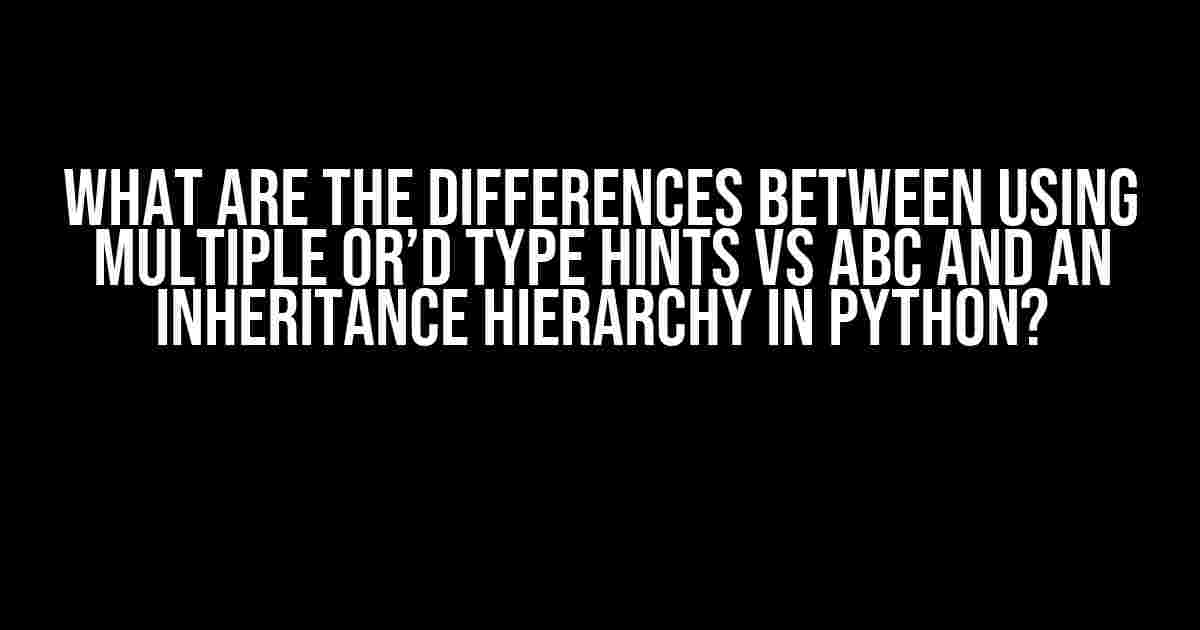Welcome to the world of Python type hints, where the debate rages on about the best way to type hint your code. In this article, we’ll delve into the age-old question: what are the differences between using multiple or’d type hints vs ABC (Abstract Base Classes) and an inheritance hierarchy in Python?
The Basics: Type Hints and ABCs
Before we dive into the main event, let’s cover the basics. Type hints, introduced in Python 3.5, are a way to add type information to your code without affecting the runtime behavior. You can think of them as a way to communicate with other developers (and yourself) about the expected types of variables, function parameters, and return types.
def greet(name: str) -> None:
print(f"Hello, {name}!")
In this example, we’re telling Python that the `name` parameter should be a string, and the function returns nothing (i.e., `None`).
from abc import ABC, abstractmethod
class Animal(ABC):
@abstractmethod
def sound(self) -> None:
pass
In this example, we’re defining an abstract class `Animal` with an abstract method `sound`. Any class that inherits from `Animal` will need to implement the `sound` method.
Multiple or’d Type Hints
Now that we’ve covered the basics, let’s talk about multiple or’d type hints. This approach involves using the `|` character to specify multiple types for a single variable or function parameter.
def process_data(data: str | int | float) -> None:
# process data
In this example, we’re telling Python that the `data` parameter can be either a string, integer, or float. This approach is useful when you need to handle different types of data in a single function or method.
ABC and Inheritance Hierarchy
The alternative approach is to use ABCs and an inheritance hierarchy. Instead of using multiple or’d type hints, you can define an abstract base class with an abstract method, and then create concrete classes that inherit from the ABC and implement the abstract method.
from abc import ABC, abstractmethod
class Processor(ABC):
@abstractmethod
def process(self, data) -> None:
pass
class StringProcessor(Processor):
def process(self, data: str) -> None:
# process string data
class IntProcessor(Processor):
def process(self, data: int) -> None:
# process integer data
class FloatProcessor(Processor):
def process(self, data: float) -> None:
# process float data
In this example, we’re defining an abstract base class `Processor` with an abstract method `process`. We then create three concrete classes (`StringProcessor`, `IntProcessor`, and `FloatProcessor`) that inherit from `Processor` and implement the `process` method for their respective types.
Key Differences
So, what are the key differences between using multiple or’d type hints vs ABC and an inheritance hierarchy?
Readability and Maintainability
Multiple or’d type hints can make your code more concise, but they can also lead to a cluttered and hard-to-read type hint. ABCs and an inheritance hierarchy, on the other hand, promote a more modular and organized code structure.
# Concise, but cluttered
def process_data(data: str | int | float) -> None:
# process data
# Modular and organized
class Processor(ABC):
@abstractmethod
def process(self, data) -> None:
pass
class StringProcessor(Processor):
def process(self, data: str) -> None:
# process string data
class IntProcessor(Processor):
def process(self, data: int) -> None:
# process integer data
class FloatProcessor(Processor):
def process(self, data: float) -> None:
# process float data
Type Checking and Inference
Multiple or’d type hints can make it harder for type checkers and IDEs to infer the correct type of a variable or function parameter. ABCs and an inheritance hierarchy, on the other hand, provide a clear and explicit type hierarchy that makes it easier for type checkers and IDEs to infer the correct type.
# Type checker may struggle to infer the correct type
def process_data(data: str | int | float) -> None:
# process data
# Clear and explicit type hierarchy
class Processor(ABC):
@abstractmethod
def process(self, data) -> None:
pass
class StringProcessor(Processor):
def process(self, data: str) -> None:
# process string data
class IntProcessor(Processor):
def process(self, data: int) -> None:
# process integer data
class FloatProcessor(Processor):
def process(self, data: float) -> None:
# process float data
Extensibility and Flexibility
ABCs and an inheritance hierarchy provide a more extensible and flexible way to handle different types of data. You can easily add new concrete classes to handle new types of data without modifying the existing code.
# Easy to add new types
class Processor(ABC):
@abstractmethod
def process(self, data) -> None:
pass
class StringProcessor(Processor):
def process(self, data: str) -> None:
# process string data
class IntProcessor(Processor):
def process(self, data: int) -> None:
# process integer data
class FloatProcessor(Processor):
def process(self, data: float) -> None:
# process float data
# Add a new type
class ByteProcessor(Processor):
def process(self, data: bytes) -> None:
# process byte data
Performance
In terms of performance, multiple or’d type hints have a negligible impact on the runtime performance of your code. ABCs and an inheritance hierarchy, on the other hand, may introduce a small performance overhead due to the additional indirection and method lookup.
When to Use Each Approach
So, when should you use multiple or’d type hints, and when should you use ABCs and an inheritance hierarchy?
Use Multiple or’d Type Hints:
- When you need to handle a small number of unrelated types.
- When you need to provide a concise and flexible way to type hint a variable or function parameter.
- When you’re working with existing code that doesn’t have a clear inheritance hierarchy.
Use ABCs and an Inheritance Hierarchy:
- When you need to handle a large number of related types with a clear inheritance hierarchy.
- When you need to provide a modular and organized way to type hint a variable or function parameter.
- When you’re designing a new system or framework that requires a clear and explicit type hierarchy.
Conclusion
In conclusion, multiple or’d type hints and ABCs with an inheritance hierarchy are two different approaches to type hinting in Python. While multiple or’d type hints provide a concise and flexible way to type hint a variable or function parameter, ABCs and an inheritance hierarchy provide a more modular, organized, and extensible way to handle different types of data.
By understanding the strengths and weaknesses of each approach, you can make an informed decision about which one to use in your Python projects.
Additional Resources
Thanks for reading, and happy coding!
Frequently Asked Question
Are you stuck deciding between using multiple or-ed typehints versus ABC and an inheritance hierarchy in Python? Well, you’re in luck because we’ve got the answers to your most pressing questions!
Q: What is the main difference between using multiple or-ed typehints and ABC with an inheritance hierarchy?
The main difference lies in their purpose and functionality. Multiple or-ed typehints are used to specify that a function or method can accept multiple types of arguments, whereas ABC (Abstract Base Classes) with an inheritance hierarchy is used to create a hierarchical structure of related classes that can be used for type checking and polymorphism.
Q: When should I use multiple or-ed typehints, and when should I use ABC with an inheritance hierarchy?
Use multiple or-ed typehints when you need to specify that a function or method can accept multiple unrelated types of arguments. On the other hand, use ABC with an inheritance hierarchy when you need to create a hierarchical structure of related classes that can be used for type checking and polymorphism.
Q: Can I use both multiple or-ed typehints and ABC with an inheritance hierarchy together in the same project?
Yes, you can definitely use both approaches together in the same project. In fact, it’s a good practice to use multiple or-ed typehints for simple type checking and ABC with an inheritance hierarchy for more complex type checking and polymorphism.
Q: Are there any performance differences between using multiple or-ed typehints and ABC with an inheritance hierarchy?
In terms of performance, using multiple or-ed typehints is generally faster than using ABC with an inheritance hierarchy because it involves less overhead. However, the performance difference is usually negligible, and you should prioritize code readability and maintainability over performance concerns.
Q: Which approach is more Pythonic, using multiple or-ed typehints or ABC with an inheritance hierarchy?
The Pythonic approach depends on the specific use case. However, in general, using ABC with an inheritance hierarchy is considered more Pythonic because it follows the EAFP (Easier to Ask for Forgiveness than Permission) principle and promotes code readability and maintainability.



